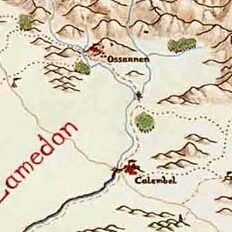|
Ossarnen
| |
|
Locale isometric view (MERP)
| |
|
Ossarnen area map (MERP)
| |
|
Type
|
|
|
Province
|
|
|
Realm
|
|
- Nigh the town of Ossarnen were those seven standing stones known as the Setmaenen. We have read in the treatise of Lhamhir the Wise that Setmaenen was an ancient name in the Daenael tongue, in which one may discern the words "set(i)em", "seven", and "aen", "stone", The name of the town Ossarnen was itself a translation of this pagan name into Sindarin, though the ending -sarnen, "stones" was a regrettable corruption, being modeled after Daenael "-aenen" of the same meaning. The Sindarin name of the town should have properly been Ossern. -Findegil of Gondor
Setmaenen, known as Ossarnen to the Dúnedain and urban Gondorians, was a small mining town in the province of Lamedon and place of an ancient holy site of the Mountainmen, situated well off the main road through inland Gondor.
- Type: Walled Town
- Inhabitants: 85% Gondorian,15% Daen
- Population: 1,400
- Origin: Settled by Gondorians around SA 3350; granted a royal charter in TA 792
- Purpose: A supply center for mining communities in the White Mountains.
- Symbol: A Miner's Lamp
Description[]
Lamedon's second largest settlement was Ossarnen, a small mining town, this name alluded to the most prominent features of the Setmaenen Stones, a pre-Númenórean ceremonial complex of megalithic structures outside the town. It's affairs and the mines were managed by a squire, appointed by the king and responsible to the lord. The squire employed the miners and loggers, he got a share of the profits, the lord took a share for the province, and the king got the rest (a modest contribution at best). Parallel to the development of hereditary lordship, the squiredom of Ossarnen became hereditary at the end of the seventeenth century of the Third Age. There was no garrison in the town, but the Miners' Guild organized patrols responsible for the street peace and fire defense.
The Guild Elders were Ossarnen's equivalent of Calembel's town council, reflecting the fact that Ossarnen was a highly specialized community where almost every single one of its 1,500 inhabitants was somehow involved in the mining business. The town was founded at the end of the ninth century, when a deposit of iron ore was rediscovered in one of the mountains of the sources of the Ciril. Ossarnen experienced about a century and a half of hectic activity, after which both the ore and the forests of the nearby mountain sides were all but depleted. The town then dwindled, and its remaining inhabitants made a living out of the low-grade ore that was left in the area. The town lay on a low, level mountain shoulder, half a mile from the main entrance to the mine, outside of which a scorched area marked the iron production site. A small tributary to the young Ciril conveniently supplied power to the bellows and forging hammers. Most of the time, the mountain side was wrapped in a thin veil of brownish smoke from the smelting ovens. The Ciril, merely an over-sized mountain brook at this point, ran in its rocky bed below the town. The ore was smelted into iron bars, which were taken downriver to Calembel on rafts. There, both the iron and the raft logs were sold, the latter as firewood.
After its boom-town youth, Ossarnen became a settled, conservative town whose inhabitants had generations of miners among their ancestors. Its residents tended to be a bit provincial in their tastes, which favored the rugged styles of the Daen-natives in the region. Few of the approximately 200 wooden houses had more than one story, but among those that did could be noticed the Guildhall (the gathering-place of the miners and their families — almost everyone) and the Squire's Quarters.
Places of Note[]
- Guildhall
- Haedrec's Cave
- Hoeg's House
- iron production site
- Old Mine (Setmaenen)
- Ruem's Hut
- Squire's Quarters


